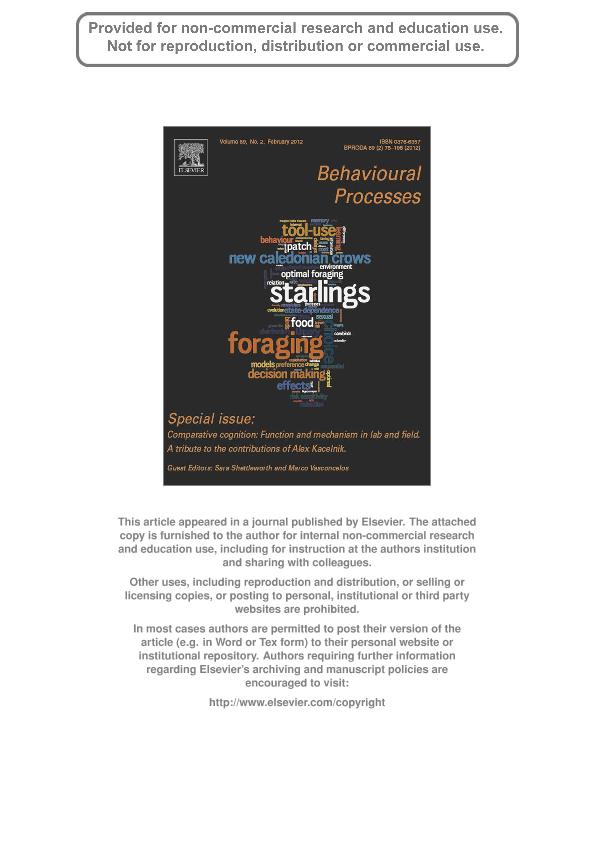Mostrar el registro sencillo del ítem
dc.contributor.author
Tuero, Diego Tomas

dc.contributor.author
Fiorini, Vanina Dafne

dc.contributor.author
Reboreda, Juan Carlos

dc.date.available
2019-01-17T19:58:39Z
dc.date.issued
2012-02
dc.identifier.citation
Tuero, Diego Tomas; Fiorini, Vanina Dafne; Reboreda, Juan Carlos; Do shiny cowbird females adjust egg pecking behavior according to the level of competition their chicks face in host nests?; Elsevier Science; Behavioural Processes; 89; 2; 2-2012; 137-142
dc.identifier.issn
0376-6357
dc.identifier.uri
http://hdl.handle.net/11336/68222
dc.description.abstract
Interspecific brood parasites, like the shiny cowbird (Molothrus bonariensis), lay eggs in nests of other species. Shiny cowbird females peck and puncture eggs when they parasitize host nests. This behavior increases the survival of cowbird chicks when they have to compete for food with larger nestmates. However, cowbird chicks may benefit from smaller nestmates as they increase food provisioning by parents and the cowbird chicks secure most extra provisioning. We investigated whether egg-pecking behavior by female shiny cowbirds might be adjusted to the competition that their chicks face in host nests. We found that more host eggs are destroyed per cowbird egg laid in a larger-bodied host (chalk-browed mockingbird, Mimus saturninus, 70-75. g) than a smaller-bodied host (house wrens, Troglodytes aedon, 12-13. g). We also tested egg-pecking preferences in choice experiments with female cowbirds in captivity and found cowbirds presented with eggs in artificial nests pecked first and more frequently, and punctured more frequently the larger egg when this was a host egg, but not when this was a cowbird egg. Our results are partially consistent with the hypothesis that shiny cowbird females adaptively adjust their egg pecking behavior according to the competition that their chicks face in host nests.
dc.format
application/pdf
dc.language.iso
eng
dc.publisher
Elsevier Science

dc.rights
info:eu-repo/semantics/openAccess
dc.rights.uri
https://creativecommons.org/licenses/by-nc-nd/2.5/ar/
dc.subject
Brood Parasitism
dc.subject
Cowbirds
dc.subject
Egg Punctures
dc.subject
Molothrus
dc.subject
Virulence
dc.subject.classification
Otras Ciencias Biológicas

dc.subject.classification
Ciencias Biológicas

dc.subject.classification
CIENCIAS NATURALES Y EXACTAS

dc.title
Do shiny cowbird females adjust egg pecking behavior according to the level of competition their chicks face in host nests?
dc.type
info:eu-repo/semantics/article
dc.type
info:ar-repo/semantics/artículo
dc.type
info:eu-repo/semantics/publishedVersion
dc.date.updated
2019-01-17T13:56:17Z
dc.journal.volume
89
dc.journal.number
2
dc.journal.pagination
137-142
dc.journal.pais
Países Bajos

dc.journal.ciudad
Amsterdam
dc.description.fil
Fil: Tuero, Diego Tomas. Consejo Nacional de Investigaciones Científicas y Técnicas. Oficina de Coordinación Administrativa Ciudad Universitaria. Instituto de Ecología, Genética y Evolución de Buenos Aires. Universidad de Buenos Aires. Facultad de Ciencias Exactas y Naturales. Instituto de Ecología, Genética y Evolución de Buenos Aires; Argentina
dc.description.fil
Fil: Fiorini, Vanina Dafne. Consejo Nacional de Investigaciones Científicas y Técnicas. Oficina de Coordinación Administrativa Ciudad Universitaria. Instituto de Ecología, Genética y Evolución de Buenos Aires. Universidad de Buenos Aires. Facultad de Ciencias Exactas y Naturales. Instituto de Ecología, Genética y Evolución de Buenos Aires; Argentina
dc.description.fil
Fil: Reboreda, Juan Carlos. Consejo Nacional de Investigaciones Científicas y Técnicas. Oficina de Coordinación Administrativa Ciudad Universitaria. Instituto de Ecología, Genética y Evolución de Buenos Aires. Universidad de Buenos Aires. Facultad de Ciencias Exactas y Naturales. Instituto de Ecología, Genética y Evolución de Buenos Aires; Argentina
dc.journal.title
Behavioural Processes

dc.relation.alternativeid
info:eu-repo/semantics/altIdentifier/doi/http://dx.doi.org/10.1016/j.beproc.2011.10.012
dc.relation.alternativeid
info:eu-repo/semantics/altIdentifier/url/https://www.sciencedirect.com/science/article/pii/S037663571100218X
Archivos asociados
